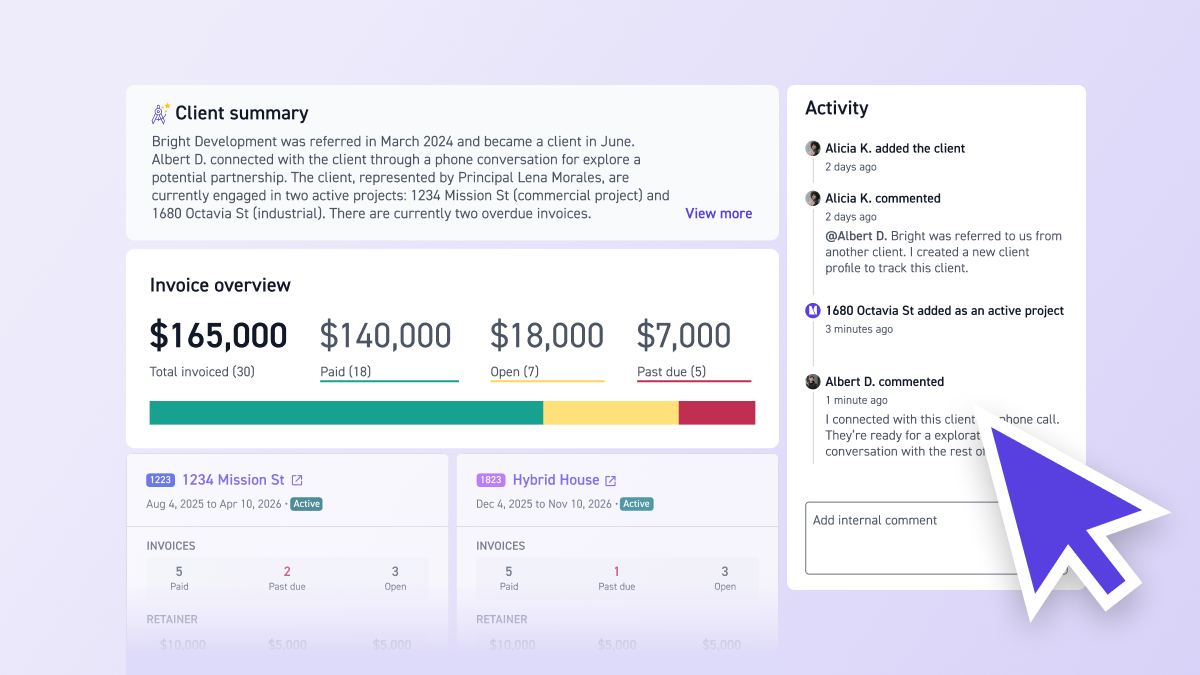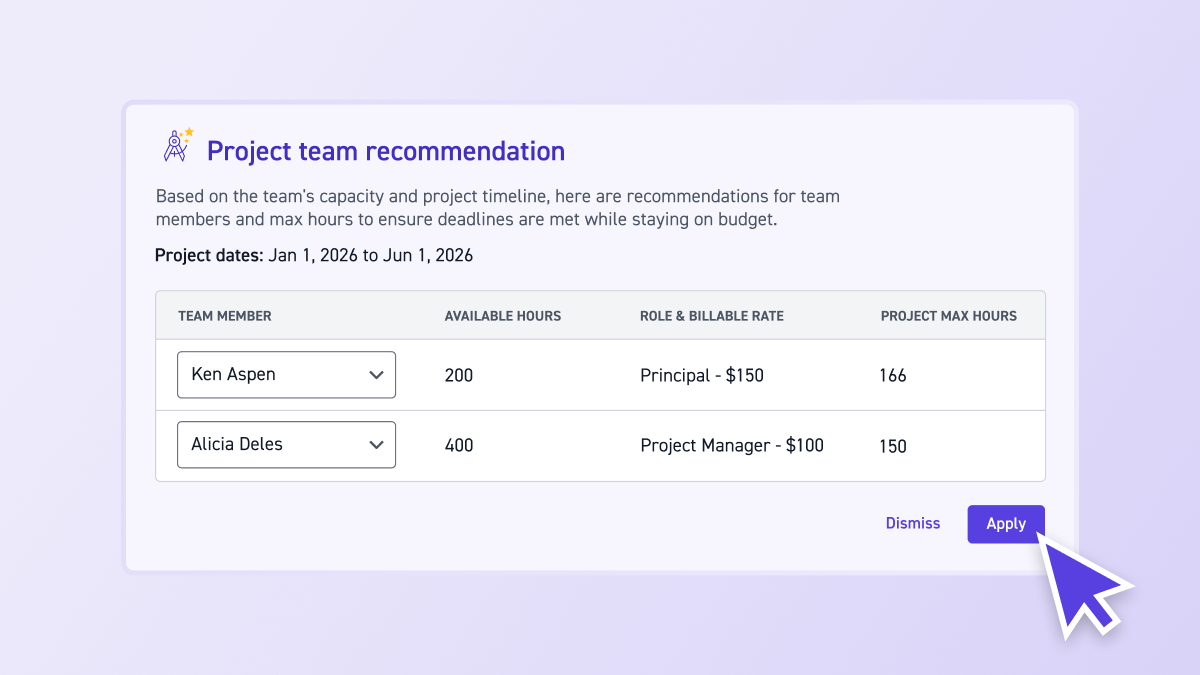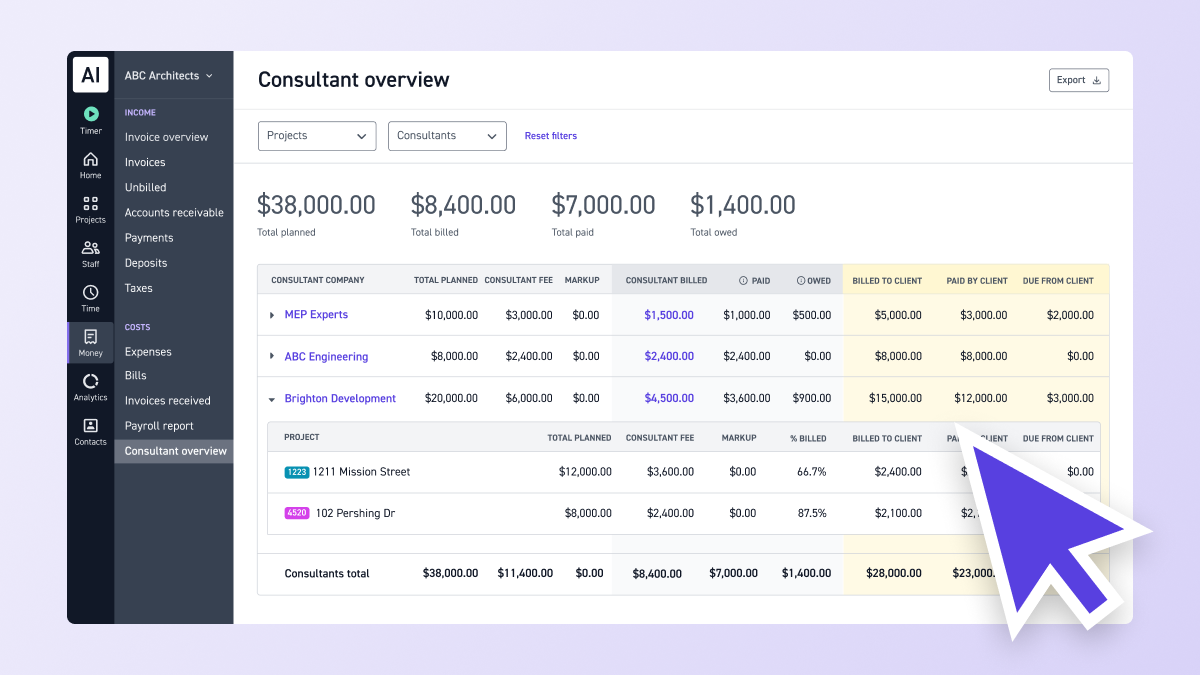Contents
When Client Information Lives Everywhere, Nothing Stays Connected
You have a client call in 10 minutes, but you're scrambling through email, spreadsheets, and QuickBooks trying to piece together their contact information, projects, and payment history.
Client information lives everywhere: contact details in email signatures, project lists in spreadsheets, invoice status in QuickBooks, payment history in accounting software, relationship notes in someone's memory. You can't see which invoices are overdue, which clients are slow-paying, or which projects need payment follow-ups. Every hunt takes time away from managing relationships and getting paid.
This problem compounds when it comes to payments. According to our 2025 Architecture & Engineering Business Benchmarks Report, low-performing firms wait 42 days to get paid—12 days past due on a net 30 invoice. Worked June 1. Billed July 1. Paid August 12. That's 72 days of float across 50 projects, while you're covering salaries and rent every 30 days with no delays.
But here's the uncomfortable truth: clients aren't the only reason you're waiting. Are you billing late? Are you only accepting paper checks? Are you offering loose terms with no reminders? Without visibility into client payment history and invoice status, you can't proactively manage cash flow.
Client Hub fixes this. Click on any client to see their profile. View all projects, invoices, and retainers in one place. See AI-generated summaries that give you instant context before calls or meetings. Track activity over time with activity logs. Add internal notes like best times to call or communication preferences.
Everything connects. When you view a client profile, you see projects, invoices, retainers, activity logs, and internal notes—all in one place. Your client relationships, projects, budgets, and invoices all live in the same system, connected to the same clients. Client Hub follows the Monograph Method, specifically Principle 1: all features, all connected. This is how we build Monograph: bringing scattered information into one organized system so you stop wasting time hunting and start managing relationships effectively.
How Scattered Client Information Hurts Your Firm
When client information isn't centralized, the impact ripples across your firm. Every time someone needs client context, they're hunting across multiple systems instead of managing relationships.
What happens when client information is scattered:
- You waste time hunting for basic information. A principal has a client call but can't remember which projects they're working on, so they ask the project manager, who checks spreadsheets and email threads. A team member needs to find a client's payment history but spends 15 minutes digging through QuickBooks and email. Your finance team needs to see which invoices are past due for a specific client but has to compile information from multiple systems.
- You can't see which invoices are overdue. Your finance team needs to see which client invoices are past due but has to compile information from multiple systems. Without a central view, overdue invoices go unnoticed until they become urgent. According to our 2025 Architecture & Engineering Business Benchmarks Report, low-performing firms wait 42 days to get paid—12 days past due on a net 30 invoice.
- You can't assess client payment patterns. Someone needs to know if a client is slow-paying but that information only exists in someone's memory or scattered across multiple invoices. You can't make informed decisions about payment terms or which clients need closer follow-up.
- You can't coordinate effectively across projects. Without seeing all projects a client is working on, you can't coordinate timelines or avoid scheduling conflicts. You can't see the full picture of your client relationships.
- You lose hours every week to information hunting. These small delays add up. Ten minutes here, fifteen minutes there. Multiply that across multiple team members and multiple client interactions, and you're losing hours every week to information hunting instead of relationship management.
The real cost:
- Time wasted - You spend hours hunting for client information across multiple systems. These small delays add up: ten minutes here, fifteen minutes there. Multiply that across multiple team members and multiple client interactions, and you're losing hours every week to information hunting instead of relationship management.
- Money lost - Slow-paying clients and late invoices stall payments. When low-performing firms wait 42 days to get paid (12 days past due on net 30), that's 72 days of float across 50 projects. Meanwhile, you're covering salaries and rent every 30 days with no delays. Without visibility into which invoices are overdue and which clients are slow-paying, you can't proactively manage cash flow.
- Relationship damage - You experience poor coordination with clients, late payment follow-ups, and missed opportunities. When you can't see which clients are working on which projects, you can't coordinate timelines effectively. When you can't see which invoices are overdue, you damage relationships with late payment requests.
- Team frustration - Your team constantly hunts for information and experiences confusion about client status. Every time someone needs client context, they're hunting across multiple systems instead of managing relationships.
- Missed learning opportunities - You can't identify patterns in client payment behavior or project relationships. Without centralized information, you can't see which clients consistently pay on time and which ones need closer management.
Client Hub puts everything in one place. All your client information—projects, invoices, retainers, activity history, internal notes—is accessible from a single client profile. AI-generated summaries give you instant context before calls or meetings. Activity logs show you what's happened over time. Distribution graphs show invoice status at a glance. Everything you need is right there.
This visibility helps you generate revenue. Quick access to client payment history, invoice status, and project details helps you manage relationships and get paid faster. You know exactly where each client stands and can respond quickly.
AI-Powered Summaries That Give You Instant Context
Most client management systems show you data, but not context. You see a client's name and maybe their contact information, but you don't know their relationship history, payment patterns, or project status without digging.
Client Hub includes AI-generated summaries for each client. These summaries provide instant context about each client: relationship history, payment patterns, active projects, and key relationship details. Perfect before a meeting, a call, or when onboarding a new teammate. You get instant context without hunting through multiple systems.
Each client profile shows their AI-generated summary at the top, so you see the most important information first. The summary appears prominently on the client's profile, giving you a quick overview of their relationship with your firm. Need more details? Click through to see all projects, invoices, retainers, activity logs, and internal notes. The summary gives you a quick overview; the full profile gives you everything.
This is especially useful for A&E firms managing dozens of clients. Instead of asking teammates "what do we know about this client?" or digging through email threads to piece together context, the AI summaries give you quick answers. Smart summaries mean less hunting, less guessing, and more managing relationships effectively.
AI-powered features like client summaries help you automate your work. Skip manual information gathering and reduce admin time so you spend more time on client relationships.
See All Projects, Invoices, and Retainers in One Place
Client Hub makes finding what you need quick and simple. View all projects for a client in one place. See all invoices with distribution graphs showing Paid / Open / Past Due status at a glance. View retainer details for clearer financial visibility.
Instead of hunting through project lists, invoice systems, and accounting software, everything is in one place with visual indicators that help you understand client health quickly. Distribution graphs show payment status with clear visual breakdowns—see at a glance how much is paid, how much is open, and how much is past due. Project lists show all projects for the client with financial snapshots. Retainer details show ongoing financial relationships. Everything connected to the client, accessible from their profile.
This centralization helps with accurate project accounting. When you can see all projects, invoices, and retainers for a client in one place, you understand their full relationship with your firm. You see which invoices are overdue and which retainers are active. This helps you make better decisions about client relationships.
Track Activity and Add Internal Notes
Client relationships aren't just about projects and invoices. They're about communication preferences, relationship history, best times to call, and important context that helps you manage relationships effectively.
Client Hub includes an activity log that tracks important client activity over time. It starts with invoice activity—when invoices were sent, paid, or became overdue—with more activity types coming soon. The activity log appears as a timeline on the client's profile, showing a chronological view of interactions. This gives you a timeline of client interactions so you can see what's happened over time, making it easy to understand the history of your relationship with each client.
You can also add internal notes and comments directly in Client Hub. Record things like best time to call, preferred communication style, relationship history, or important context that helps your team manage the relationship. These notes are private and team-only, so you can keep sensitive information in one place without worrying about it being visible to clients. When you add a note, it's immediately visible to your team on the client's profile, so everyone has access to the same relationship context.
This is part of what makes Monograph work: everything in one place. Instead of keeping client notes in email threads, spreadsheets, or someone's memory, Client Hub centralizes relationship information alongside project and financial data. Your client relationships, projects, invoices, and notes all live in the same system, connected to the same clients.
Client Hub and Project Management
Client Hub works with how you already manage projects in Monograph. When you're tracking project phases, coordinating with consultants, or reviewing project details, Client Hub keeps all your client information easy to find and access.
Projects are connected to clients, so when you view a client profile, you see all their projects with financial snapshots. Invoices are connected to clients, so you see all their invoices with payment status. Retainers are connected to clients, so you see ongoing financial relationships. Everything stays connected to the client, but you can access it all from Client Hub.
This is part of what makes Monograph work: everything in one place. Instead of jumping between spreadsheets for client lists, email for contact information, QuickBooks for invoices, and project management tools for project status, Monograph brings it all together. Client Hub extends that centralization to your client relationships. Your projects, invoices, budgets, and now your client information all live in the same system, connected to the same clients.
For teams managing multiple clients, Client Hub keeps all your client information organized and accessible. You can see clients across all projects in one view, or filter down to specific clients when you need to focus. Find client information faster, share context quickly, and keep client relationships organized as your firm grows.
This is especially valuable for structural engineers and MEP engineers whose clients are often architects. When you work with multiple architect clients across different projects, Client Hub helps you see all your relationships with each architect in one place: all projects you're working on together, invoice history, payment status, and relationship context. Instead of tracking architect relationships across scattered systems, everything is connected in Client Hub. You can also collaborate with architect clients on timelines, deliverables, and billing through consultant collaboration, keeping all your architect relationships organized and accessible.
Best Practices for Using Client Hub
Add internal notes consistently. When you learn something important about a client—best time to call, preferred communication style, relationship history—add it as an internal note in Client Hub immediately. For example, if a client prefers email over phone calls, or if they're most responsive in the mornings, add that as a note. The more you use it, the more valuable it becomes as your central client information repository.
Review client profiles before calls or meetings. Use the AI-generated summaries to get instant context before important client interactions. Check activity logs to see recent invoice activity or payment updates. Review internal notes to remember important relationship details. For example, before a client call, review their AI summary to see their payment patterns, check their activity log to see recent invoice activity, and review internal notes to remember their preferred communication style.
Use search and filters to find clients quickly. Client Hub includes search and filter options to help you find what you need. Search by client name and use filters to narrow down results fast. For example, if you need to find all clients with past due invoices, use the search function or filter by payment status.
Check invoice distribution graphs regularly. The distribution graphs show Paid / Open / Past Due status at a glance, so you can quickly identify clients with payment issues. Use this to prioritize follow-ups and manage cash flow proactively. For example, if you see a client with a large "Past Due" amount in their distribution graph, follow up immediately to avoid further delays in payment.
Frequently Asked Questions
Where do I find Client Hub? Client Hub is in Contacts > Clients (Client Directory). Navigate to Contacts > Clients to see all your clients in one place. Click on any client to open their profile and see all connected information.
What information appears in Client Hub? All client information appears in Client Hub, including client profiles, all projects for each client, all invoices tied to each client, retainer details, activity logs, and internal notes.
Can I customize what I see in Client Hub? Client Hub includes search and filter options to help you find what you need. You can search by client name and filter by various criteria to narrow down results. The client table shows the most relevant information at a glance.
What are AI-generated client summaries? AI-generated summaries provide instant context about each client. These summaries give you quick information before calls or meetings without hunting through multiple systems.
Can I add notes about clients? Yes. You can add internal notes and comments directly in Client Hub. These notes are private and team-only, so you can record important relationship information like best time to call, preferred communication style, or relationship history.
What activity appears in the activity log? The activity log currently tracks invoice activity—when invoices were sent, paid, or became overdue. More activity types are coming soon, so you'll be able to track a wider range of client interactions over time.
How do I see all projects for a client? Click on any client to open their profile, then navigate to the Projects section. You'll see all projects for that client with financial snapshots and distribution graphs showing Paid / Open / Past Due status.
How do I see all invoices for a client? Click on any client to open their profile, then navigate to the Invoice Dashboard. You'll see a complete list of all invoices tied to that client with a distribution graph showing Paid / Open / Past Due status at a glance.
Learn more about managing clients




